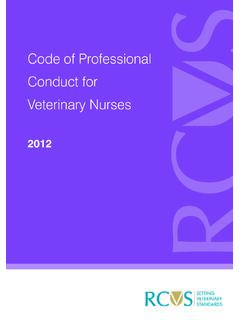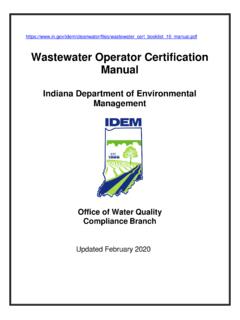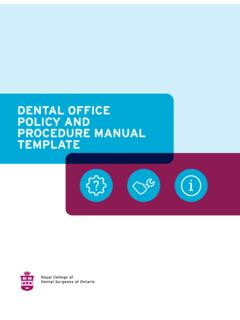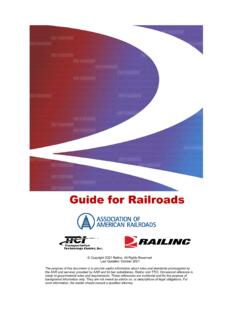Transcription of RCVS Day One Skills for Veterinary Nurses
1 Day One Skills List 2016 small animal 1 RCVS Day One Skills for Veterinary Nurses Introduction a. Licence to practise qualifications leading to entry onto the Veterinary Nurse Register must articulate with the RCVS Day One Skills for Veterinary Nurses and be specified, recorded and assessed in a format that is readily auditable and accessible to learners. b. The Day One Skills list is a regulatory benchmark of essential clinical Skills , developed and reviewed by the RCVS, based on the RCVS Day One Competences for Veterinary Nursing. The Skills list is embedded in an electronic nursing progress log (the NPL) which has been designed to support a process of clinical mentorship and learning in addition to recording competence achievement.
2 Awarding institutions may use the NPL or develop their own recording systems. c. There are Day One Skills for Veterinary Nursing in relation to the care of either horses (or other equidae) or small animals, which should include dogs, cats and exotic species, or a combination of the three. d. The RCVS Code of Professional Conduct sets out Veterinary Nurses professional responsibilities. Where applicable the RCVS Day One Skills for Veterinary Nursing has been referenced to the Code of Professional Conduct for Veterinary Nurses and the relevant supporting guidance which should be referred to, by student Veterinary Nurses , when completing the Skills . RCVS Day One Skills for Veterinary Nursing Small Animal Section 1 Legislation affecting practice Relevant day one competences 3.
3 Demonstrate knowledge of the organisation and legislation related to a Veterinary business 4. Promote, monitor and maintain health and safety in the Veterinary setting; demonstrate knowledge of systems of quality assurance ; apply principles of risk management to their practice 21. Recognise suspicious signs of possible notifiable, reportable and zoonotic diseases and take appropriate action, including observing the appropriate health and safety recommendations Skill Guidance 1. Comply with Health and Safety requirements and local risk factors Comply with legislative requirements Day One Skills List 2016 small animal 2 2. Follow Standard Operating Procedures and manufacturer guidelines when using equipment and materials 3. Take appropriate action and report injury to self or others 4.
4 Carry out a risk assessment for one area of the practice and instigate appropriate action 5. Comply with the requirements for reporting notifiable diseases and reportable diseases and injuries under RIDDOR Professional discussion in relation to notifiable diseases and reporting is an acceptable assessment method for this skill Section 2 Communication Relevant day one competences 5. Communicate effectively with clients, the public, professional colleagues and responsible authorities, using language appropriate to the audience concerned 6. Prepare accurate clinical and client records, and laboratory reports when necessary, in a form satisfactory to colleagues and understandable by the public 7. Work effectively as a member of a multi-disciplinary team in the delivery of services 8.
5 Understand the economic and emotional context in which the Veterinary nurse operates 9. Be able to review and evaluate literature and presentations critically 10. Understand and apply principles of clinical governance, and practise evidence-based Veterinary nursing 11. Demonstrate ability to cope with incomplete information, deal with contingencies, and adapt to change 19. Communicate clearly and collaborate with referral and diagnostic services, ensuring they receive an appropriate history from the Veterinary surgeon. 31. Understand the appropriate need for euthanasia; sensitively support the owner and others with due regard for health and safety of those present; advise on disposal of the carcase 32. Advise clients on programmes of preventative medicine appropriate to species Day One Skills List 2016 small animal 3 Skill Guidance 1.
6 Communicate effectively using a variety of different methods see supporting guidance: 5 communication between professional colleagues Communicate with clients, work colleagues, other Veterinary professionals and the public. Communication models should be followed where applicable 2. Create accurate and legible written communications according to practice policy Records to include: patient records and reports, laboratory reports, admission and consent forms, client home care plans and instructions 3. Access and store client and practice records according to practice policy and data protection laws see supporting guidance: 14 client confidentiality 4. Admit patients see supporting guidance: 1 referrals and second opinions 9 practice information, fees and insurance 11 communication and consent Obtain written and verbal informed consent; Respond appropriately to economic status of clients to include insurance and charity referrals 5.
7 Conduct effective nursing consultations See supporting guidance: 18 delegation to Veterinary Nurses History taking and appropriate examination; Identifying patients for referral to a Veterinary surgeon; Application of treatments; Programmes of preventative medicine; Implant a microchip 6. Provide discharge information and guidance to owners Advise clients on safe and correct routes of administration and potential side effects; Demonstrate to clients safe techniques for administering medication; Advise clients on the storage and disposal of medication; Wound care advice; Bandage advice 7. Complete appropriate paperwork for referral and diagnostic services See supporting guidance: 13 clinical and client records This links to Laboratory Skill 8 To include laboratory samples, clinical histories and hereditary tests Day One Skills List 2016 small animal 4 8.
8 Practise evidence-based nursing Appraise literature; Discuss findings with practice team 9. Collaborate with inter-professional colleagues to improve professional practice and relationships see supporting guidance: 5 communication between professional colleagues 17 Veterinary teams and leaders Consult the Veterinary team in the event of unexpected medical or surgical complications, serious complaint, accident or anaesthetic death; Consider mitigating circumstances; Ensure effective protocols are in place; Communicate changes to the practice team 10. Communicate effectively expressing appropriate empathy and sympathy See supporting guidance: 8 Euthanasia of animals Prepare the owner for loss; Support the owner through the euthanasia process; Provide follow-up support for a bereaved owner; Maintain and adapt professional approach to the circumstances Section 3 Handling and restraint Relevant day one competences 14.
9 Handle and restrain animal patients safely and humanely, and instruct others in helping the Veterinary surgeon perform these techniques. Skill Guidance 1. Evaluate behavioural and environmental factors when approaching and handling animals Recognition of and minimising fear and distress 2. Transport animals using approved manual handling and lifting procedures 3. Select and wear appropriate personal protective equipment 4. Demonstrate techniques for approaching and catching animals 5. Lead and move animals using the most appropriate equipment for the species Day One Skills List 2016 small animal 5 6. Use appropriate restraint methods suitable for the patient and situation with due consideration for animal welfare Maintain patients emotional homeostasis and wellbeing; Recognise signs of distress and act accordingly to minimise this; Restrain for clinical examination, sample collection, administration of medicines and introduction of an appropriate airway management device Section 4 Nursing care Relevant day one competences 15.
10 Deliver nursing care in accordance with best practice and due regard to animal welfare 16. Develop appropriate care plans and administer care in the interests of the patients and with regard to the resources available 17. Administer emergency first aid and assist with the provision of emergency treatment to animals. 24. Be aware of suspected adverse reactions and alert the Veterinary surgeon 30. Assess pain and alert the Veterinary surgeon Skill Guidance 1. Use an appropriate model of care to deliver the nursing process and create care plans for a range of disorders and diseases Interpret nursing care plans and carry out appropriate nursing interventions 2. Carry out a nursing assessment ascertaining information about the patient s normal routine Food and fluid intake; Urination and defecation; Behaviour (response to pain, strangers, commands etc); Mobility; Sleep and rest; Maintain your own hygiene levels 3.









